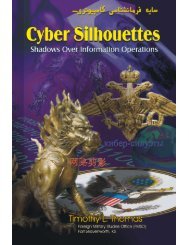Uyghurs Without Borders? - Foreign Military Studies Office - U.S. Army
Uyghurs Without Borders? - Foreign Military Studies Office - U.S. Army
Uyghurs Without Borders? - Foreign Military Studies Office - U.S. Army
Create successful ePaper yourself
Turn your PDF publications into a flip-book with our unique Google optimized e-Paper software.
7 James A. Millward and Nabijan Tursun, “Political Histories and Strategies of Control, 1884-1978,” in Xinjiang:China’s Muslim Borderland, ed. S. Frederick Starr, (New York: Central Asian-Caucasus Institute, 2004), pp. 63-98.8 For one of the most in depth backgrounds on the recent history of <strong>Uyghurs</strong> in Kazakhstan see: Sean R. Roberts,“The Uighurs of the Kazakhstan borderlands: Migration and the nation,” Nationalities Papers 26, no. 3 (1998): pp.511-530.9 Ibid.10 Marlene Laruelle and Sebastien Peyrouse, “Cross-border Minorities as Cultural and Economic Mediatorsbetween China and Central Asia,” China and Eurasia Forum Quarterly 7, no. 1 (2009): pp. 93-119.11 Roberts, “The Uighurs of the Kazakhstan borderlands,” pp. 511-530.12 For an more in depth look at <strong>Uyghurs</strong> in Kazakhstan from a Uyghur point of view, see the website “<strong>Uyghurs</strong> ofKazakhstan” (in Russian), 13 The populations of other minorities in multiethnic Kazakhstan, such as Russians, Ukrainians, and Germans, areshrinking, but the number of <strong>Uyghurs</strong> has grown steadily over the last 20-30 years. This is demonstrated in thecensuses taken in 1979, 1989, 1999, and 2009 where <strong>Uyghurs</strong> made up 1, 1.1, 1.4, and 1.4 percent of thepopulation respectively and numbered around 223,100 people total: Natsuko Oka, "The 'Triadic Nexus' inKazakhstan: A Comparative Study of Russians, Uighurs, and Koreans," in Ieda, Osamu et al. eds., BeyondSovereignty: From Status Law to Transnational Citizenship?, Sapporo, Japan: Slavic Research Center, HokkaidoUniversity (2006): pp. 359-380; Thomas S. Szayna, “Potential for Ethnic Conflict in the Caspian Region.” Faultlinesof Conflict in Central Asia and the South Caucasus, Implications for the U.S. <strong>Army</strong>, eds. Olga Oliker and ThomasSzayna. Santa Monica, Calif.: RAND Corporation (2003): pp. 145-183; Agentstvo Respubliki Kazakhstan PoStastikike [Ministry of Statistic of the Republic of Kazakhstan]. “Itogi Perepisi Naseleniya-Respubliki Kazakhstan2009.” [Results of the Population Census of the Republic of Kazakhstan 2009]. (accessed October 6, 2010).14 Laruelle and Peyrouse, “Cross-border Minorities as Cultural and Economic Mediators between China and CentralAsia,” pp. 93-119; For the official website and information of the Uyghur District (in Russian), see http://uigurakimat.kz/(accessed December 14, 2010).15 Martha Brill Olcott, Central Asia’s Second Chance. Washington DC: Carnegie Endowment for International Peace,2005, pp. 30-36.16 Calla Wiemer, “The Economy of Xinjiang,” in Xinjiang: China’s Muslim Borderland, ed. S. Frederick Starr, (NewYork: Central Asian-Caucasus Institute, 2004), pp. 163-189; Sebastien Peyrouse, “Chinese Presence in Kazakhstan:China’s Resolve and Central Asia’ Apprehension,” China Perspectives 3 (2008): pp. 34-49.17 Peyrouse, “Chinese Presence in Kazakhstan: China’s Resolve and Central Asia’ Apprehension,” pp. 34-49.18 Wiemer, Xinjiang: China’s Muslim Borderland, pp. 163-189.19 Peyrouse, “Chinese Presence in Kazakhstan: China’s Resolve and Central Asia’ Apprehension,” pp. 34-49.20 Wiemer, Xinjiang: China’s Muslim Borderland, pp. 163-189.15
















